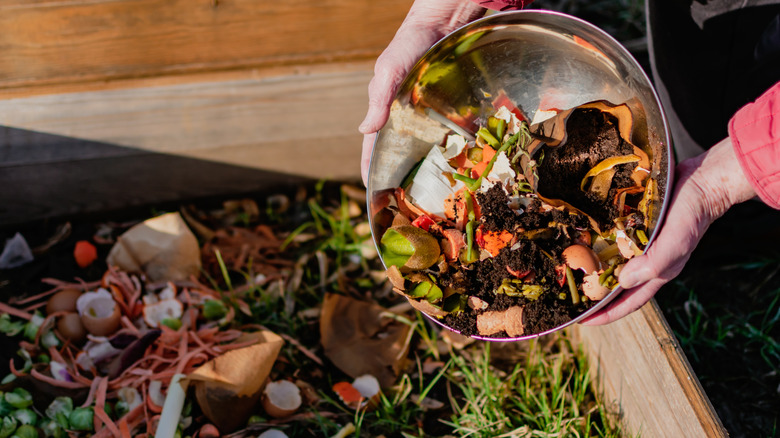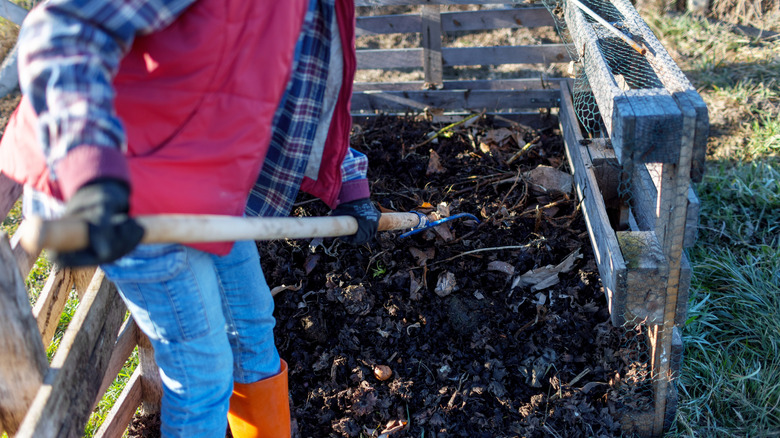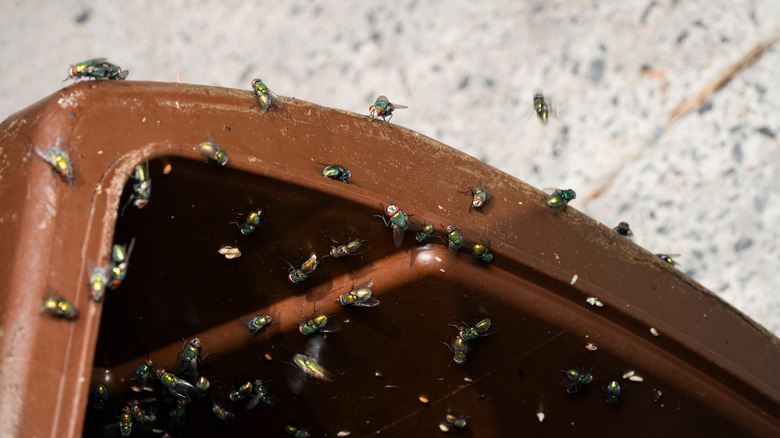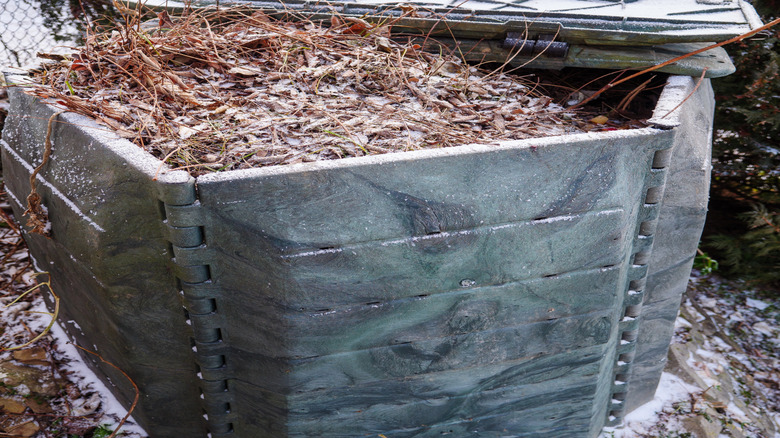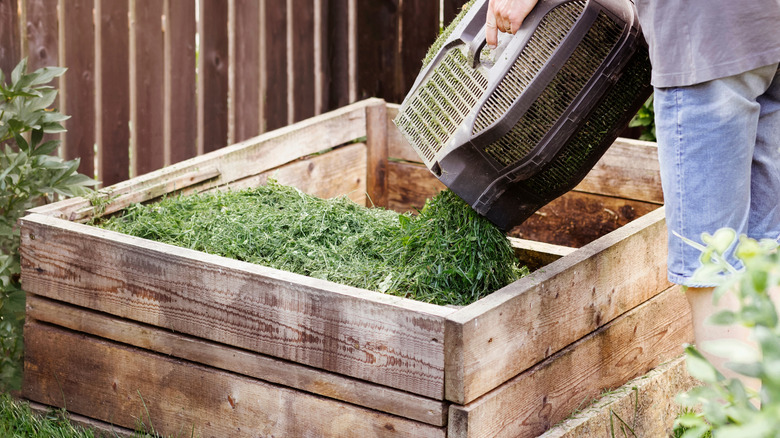Downsides Of An Outdoor Compost Bin You Haven't Thought About
We may receive a commission on purchases made from links.
Outdoor composting is often pushed as the eco-friendly solution for kitchen and yard waste — an easy bin that produces the perfect garden food. However, there are many unexpected drawbacks that homeowners may not consider when delving into the composting world. Unlike indoor composting systems that work in a controlled environment, outdoor bins are at the mercy of weather, pests, and seasonal changes that can completely change the results. Odor control is the most obvious issue — what starts as a mild, earthy scent can quickly turn potent during the summer heat. Temperature changes not only affect the smell but also the microbial activity needed for proper decomposition. Winter freezes can slow decomposition dramatically, and summer heat can kill beneficial organisms, leaving you with stalled compost for months.
Animal issues can also arise; raccoons, rats, and strays are sometimes attracted to the food scraps inside an outdoor bin. Rodent-proofing your compost system is possible, but it will potentially add extra expenses to what initially feels like a low-cost project. There are some homemade methods to pest prevention, though, like specific herbs and spices that you can add to your compost pile to help combat this problem. The location of your bin is also something to consider. Bins need to be accessible all year long but far enough from the house to avoid smells and pests, which can be difficult to achieve in smaller yards.
The labor and time investment of outdoor composting
Composting can sometimes come off as an easy task — toss food scraps in a bin, and out comes plant food in a few months. But that is not at all the reality. Outdoor composting requires a lot of attention to maintain proper moisture levels. Too wet and it becomes a smelly, anaerobic mess; too dry and decomposition grinds to a halt. An ideal range is between 40 and 60% moisture — look for the texture of a wrung-out sponge. During rainy seasons, uncovered piles can become waterlogged within hours, requiring more dry, brown materials to counterbalance the moisture. During dry spells, you may need to add water or food items with lots of water. You'll also need to consistently turn the pile weekly during summer months, a tough task that involves you wrestling with heavy, partially decomposed materials.
Temperature monitoring is also incredibly important and requires your attention. To kill weed seeds and pathogens, compost must maintain an internal temperature between 131 to 160 degrees Fahrenheit. Hitting this goal requires precise layering, frequent turning, and sometimes even extra insulation around your bin during the cooler months. Once you have created some perfect compost, you'll need to harvest it. Sifting out finished compost involves using a sieve or screen to get the good stuff separated away from unfinished chunks. Oftentimes, this will leave you with much less usable material than you initially expected and cause problems when you're trying to figure out how much compost you should be adding to your garden. If your household generates a high amount of food waste, you might want to consider multiple compost bins being used in rotation, which adds more work just to keep up.
Neighborhood troubles, pest infestations, and regulatory headaches
Composting is dirty work, and keeping it contained to your designated area takes effort. Odors can quickly drift across property lines, leading to tension between neighbors and possibly municipal citations. Some homeowner associations have strict rules about compost bin placement, and cities might mandate specific bin types as well. Others can even require permits for open piles of certain sizes, so make sure you research any regulations that may apply to your area. This usually doesn't apply to home compost piles, but it's always better to check first.
Insect infestations create even more headaches. Outdoor bins can become breeding grounds for fruit flies and gnats, which inevitably find their way indoors during the warm months. These pests can spread quickly, with some fly species producing new generations every one to three weeks under ideal conditions. The bins will also attract unwelcome visitors like yellowjackets and wasps that like to nest in warm, protected environments. While these stinging insects can be beneficial in your garden, they could also create an unsafe environment outside for families with young children and pets. There are also some simple mistakes you could be making that attract larger pests to your outdoor compost bin. Specific types of food waste and lack of turning could create a delicious buffet for unwanted critters, for instance.
Seasonal struggles of outdoor composting
Composting outside is far from a year-round solution in most climates. The winter chill brings microbial activity to a near standstill, leaving piles frozen for months with no decomposition progress. Attempting to compost through cold months can be achieved, but it comes with the extra expense of insulated bins or heating systems that tack on electricity costs as well. On the other hand, summer droughts create different problems. Without regular watering, which might be restricted in your area during dry spells, piles can become a mass of unusable dried vegetation.
Humid climates also have their own challenges. The combination of heat and moisture, while helping with the composting process, can create the perfect condition for harmful molds like aspergillus, which can release spores when the pile is being disturbed. Coastal areas have salty air to contend with, which can disrupt microbial balances, and desert regions struggle with fast moisture evaporation and excessive heat, killing beneficial organisms. Even in the perfect areas, spring and fall rains can waterlog piles, requiring constant covering and uncovering, which defeats the purpose of the "set it and forget it" idea of composting.
Is it worth composting outside and alternative solutions
Despite all the doom and gloom, outdoor composting can still be something worthwhile for many gardeners when done strategically. The main thing is to match the system to your specific needs and constraints. If you have a big yard and regular yard waste, a well-managed bin system can efficiently process leaves, plants, and grass clippings with minimal odor. In fact, leftover grass clippings are great for your compost bins as they provide high levels of nitrogen. Smaller yards may want enclosed tumblers that not only deter pests but help decomposition through easier turning. The compost you can produce in an outdoor pile is very beneficial to your soil and often much better than most store-bought alternatives. For the eco-conscious, proper compost can help lower your overall carbon footprint when compared to disposing of your waste in a dump.
If you've decided that outdoor composting isn't possible for your lifestyle, there are plenty of alternatives that can still help you meet your sustainability goals. Electric composters, like this Fylecen indoor smart compost bin, can process food scraps overnight, producing ready-to-use dry fertilizer. There are also hybrid systems that can pre-process food waste before adding it to an outdoor bin, reducing odor and speeding up decomposition time. The best solution often comes down to your own needs and a balance of ideas. Use outdoor bins for yard waste and non-food compostables, and use electric composters for food scraps. This balances environmental benefits with strategic methods, making sure your composting needs are manageable all year long.
